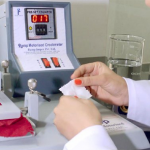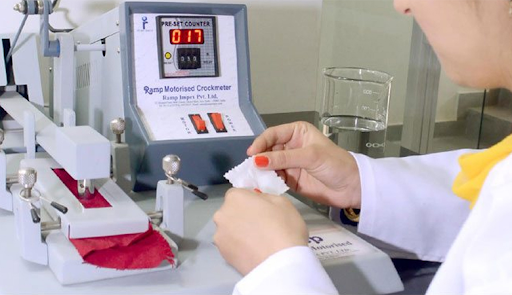
Introduction
Textiles play a significant role in our everyday lives, from the clothes we wear to the fabrics used in home furnishings. With the growing demand for high-quality textiles, manufacturers are constantly seeking advanced testing methods to ensure product integrity, performance, and environmental compliance with industry standards. In this blog post, we will explore various cutting-edge techniques used in textile analysis. These methods, from fiber identification to durability assessment, contribute to quality control, product development, and overall customer satisfaction. So, let’s dive into the world of advanced testing methods for textile analysis.

The Importance of Fiber Identification
Before delving into the advanced testing methods, it is crucial to establish the identity of the textile fibres used in a product. Fibre identification allows manufacturers to determine the composition of a fabric, enabling them to make informed decisions during the manufacturing process and ensure product quality. Here are some commonly employed fibre identification techniques:
Microscopic Analysis
Microscopic analysis involves the use of high-powered microscopes to examine the physical characteristics of textile fibres. By observing the fibre’s structure, colour, and surface features, experts can identify the type of fibre present. Microscopic analysis is particularly effective for distinguishing between natural and synthetic fibres.
Chemical Tests

Chemical tests involve subjecting textile fibres to various reagents or solvents to assess their reaction. For example, the burn test involves burning a small sample of the fibre and observing its behaviour, such as odour, flame colour, and residue. Different fibres exhibit distinct characteristics during combustion, aiding in their identification. Chemical tests are often complemented by microscopic analysis for accurate fibre identification.
Spectroscopy
Spectroscopic techniques, such as Fourier-transform infrared spectroscopy (FTIR) and Raman spectroscopy, offer non-destructive methods of fibre identification. These techniques analyse the molecular structure and chemical composition of fibres by measuring their interaction with light. Spectroscopy is highly reliable and can differentiate between different fibre types, even when they share similar visual characteristics.
Fabric Performance Analysis
Evaluating Durability and Strength
Fabric durability is a crucial aspect of textile analysis, as it directly impacts the lifespan and performance of the end product. Manufacturers employ various advanced testing methods to evaluate the durability and fabric tearing strength. Here are some notable techniques:
Tensile Strength Testing
Tensile strength testing measures the maximum force a fabric can withstand before breaking. It involves subjecting a fabric sample to controlled tension until it ruptures. This test provides valuable insights into a fabric’s ability to withstand stretching and tearing forces, aiding in the development of textiles with enhanced durability.
Abrasion Resistance Testing
Abrasion resistance testing assesses a fabric’s resistance to wear and tear caused by friction. It simulates the repetitive rubbing or scraping that textiles may experience during their lifecycle. By subjecting fabric samples to controlled abrasion using specialised equipment, manufacturers can gauge their resistance to surface damage and evaluate their overall longevity.
Pilling Resistance Testing
Pilling refers to the formation of small, tangled balls of fibre on the fabric’s surface, often caused by friction. Pilling resistance testing involves subjecting fabric samples to mechanical rubbing or using specialised devices that simulate daily wear. By quantifying the degree of pilling, manufacturers can ensure the fabric’s resistance to this common issue and enhance its overall quality.
Chemical Analytics and Compliance
In addition to fibre identification, chemical analytics plays a vital role in textile analysis, ensuring compliance with safety and regulatory standards. The following methods assist in evaluating the chemical composition of textiles:
Chromatography
Chromatographic techniques, such as gas chromatography-mass spectrometry (GC-MS) and liquid chromatography-mass spectrometry (LC-MS), are commonly used for chemical analysis in textiles. These methods separate and identify different chemical compounds present in the fabric, including dyes, finishes, and additives. Chromatography helps assess the compliance of textiles with industry regulations and standards.
X-ray Fluorescence Spectrometry

X-ray fluorescence spectrometry (XRF) is a non-destructive analytical technique that determines the elemental composition of materials. In textile analysis, XRF can detect and quantify elements used in dyes, flame retardants, and other additives. By analysing the elemental composition, manufacturers can ensure compliance with restricted substance regulations and monitor the quality of their textiles.
Conclusion
Advanced testing methods play a pivotal role in the textile industry, enabling manufacturers to enhance product quality, meet industry standards, and ensure customer satisfaction. From fibre identification techniques to fabric testing performance analysis and chemical compliance testing, these methods provide valuable insights into the composition, durability, and safety of textiles. By employing these cutting-edge techniques, manufacturers can deliver high-quality products, gain a competitive edge, and contribute to the growth of the textile industry.
FAQs
Q1: How does fibre identification impact the textile manufacturing process?
A1: Fibre identification is crucial in the textile manufacturing process as it allows manufacturers to make informed decisions about processing techniques, dye selection, and quality control measures. By accurately identifying the fibres used in fabric, manufacturers can ensure compatibility with the desired end product and optimise manufacturing parameters accordingly.
Q2: Why is pilling resistance testing important?
A2: Pilling resistance testing is essential because it helps manufacturers assess the fabric’s resistance to surface damage and maintain its aesthetic appeal over time. By understanding a fabric’s pilling propensity, manufacturers can select suitable fibres, finishes, and mechanical treatments to enhance its durability and prolong its lifespan.
Q3: How does chemical analysis contribute to textile safety?
A3: Chemical analysis ensures textile safety by identifying any harmful substances present in the fabric, such as heavy metals, carcinogenic dyes, or allergenic chemicals. By complying with safety regulations and monitoring the chemical composition of textiles, manufacturers can prioritise consumer well-being and produce textiles that meet strict safety standards.




